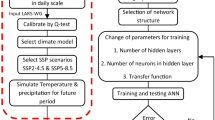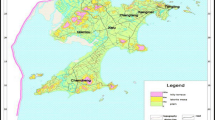Abstract
In arid and semi-arid areas, such as Tunisia, groundwater depth assessment and monitoring is an important task for groundwater resources sustainable management. The objective of this work is to assess and forecast groundwater depth (GWDs) at short-term, under different impact factors, using stochastic time series (STS) and artificial neural network (ANN). Each model was conceptualized and implemented. Groundwater depth, rainfall, pumping rate and temperature over the period 30 years extending from 1986 to 2016 were used. Root mean squared error, bias, R2, AIC, and BIC were used as sensitivity model performance criteria. Models were implemented, trained, and tested over an observation period and forecasting groundwater depth at short-term over a period 2017–2030. Results show that groundwater abstraction rates increase around 0.46 Mm3/year, whereas a groundwater depth is in continuously drawdown with a rate of 0.3 m/year which requires a monitoring network for sustainable management of water resources. The results are promising and indicate an outstanding suitability of stochastic time series and ANN models for groundwater depth assessment and predictions at short time. The predicted results at short-term will help to draw attention of local authority for clear groundwater sustainable management policy for studied area.









Similar content being viewed by others
References
Adamowski J, Chan HF (2011) A wavelet neural network conjunction model for groundwater level forecasting. J Hydrol 407(S 1–4):28–40
Agoubi B, Kharroubi A, Bouri S, Abida H (2010) Contribution of geostatistical modelling to mapping groundwater level and aquifer geometry, case study of Sfax’s deep aquifer. Tunisia Middle East J Sci Res 6(3):305–316
Agoubi B, Souid F, Telahigue F, Kharroubi A (2015) Temperature and Radon-222 as tracer of groundwater flow: application to El Hamma geothermal aquifer system, southeastern Tunisia. Arab J Geosci 8:11161–11174. https://doi.org/10.1007/s12517-015-1998-x
Akaike H (1974) New look at statistical model identification. IEEE Trans Autom Control AC 19:716–722
Arlot S, Celisse A (2010) A survey of cross-validation procedures for model selection. Statistics Surveys 4:40–79. https://doi.org/10.1214/09-SS054
Chen LH, Chen CT, Pan YG (2011) Groundwater level prediction using SOM-RBFN multisite model. J Hydrol Eng 15(8):624–631
Chu D., Hole W., 2004. The GLOBEC kriging software package EasyKrig3.0
Felisa G, Ciriello V, Antonellini M, Di Federico V, Tartakovsky DM (2015) Data-driven models of groundwater salinization in coastal plains. J Hydrol 531:187–197
Goovaerts P (1997) Geostatistics for natural resources evaluation. Oxford University Press, p 483
Issaks EH, Srivastava RM (1989) Applied Geostatistics. Oxford University Press, New York
Kashyap RL (1982) Optimal choice of AR and MA parts in autoregressive moving average models. IEEE Trans Pattern Anal Mach Intell 4(2):99–104
Khalil B, Ouarda TBMJ, St-Hilaire A (2011) Estimation of water quality characteristics at ungauged sites using artificial neural networks and canonical correlation analysis. J Hydrol 405:277–287. https://doi.org/10.1016/j.jhydrol.2011.05.024
Kitanidis PK (1997) Introduction to geostatistics, application in hydrogeology. University Press, Cambridge, pp 86–95, ISBN 0-521-58747-6
Krishna B, Rao YRS, Vijiaya T (2008) Modeling groundwater level in urban coastal aquifer using artificial neural networks. Hydrol Process 22(8):1180–1188
Lo DC, Wei CC, Tsai EP (2015) Parameter automatic calibration approach for neural-network-based cyclonic precipitation forecast models. Water 7:3963–3977. https://doi.org/10.3390/w7073963
Makni J, Ben Brahim F, Hassine S, Bouri S, Ben Dhia H (2012) Hydrogeological and mixing process of waters in deep aquifers in arid regions: south East Tunisia. Arab J Geosci 7(7):799–809. https://doi.org/10.1007/s12517-012-0793-1
Matheron G., 1970. Note de géostatistique N° 107, Krigeage universel pour une dérive aléatoire, Cahiers du Centre de Morphologie Mathematique, Ecole des Mines de Paris, Fontainebleau. 33p (in French)
McPhie S, Post R, 2016. Groundwater drought indicator lags time and barometric evaluation. Nottawasaga Valley conservation authority, 8195 8th line, utopia, ON, L0M 1T0 705–424-1479 http://www.nvca.on.ca. Accessed 15/06/2017
Noshadi M, Sepaskhah AR (2005) Application of geostatistics for potential evapotranspiration estimation. Iran J Sci Technol Trans B 29(B3):343–355
Panchal G, Ganatra A, Kosta YP, Panchal D (2011) Behaviour analysis of multilayer perceptrons with multiple hidden neurons and hidden layers. Int J Comput Theor Eng 3:332–337
Pasini A (2015) Artificial neural networks for small dataset analysis. J Thorac Dis 7:953–960
Ponce BJ, Vidal S (2011) Krige method application for the coverage analysis of a node-B in a WCDMA network. Int J Commun, Network and System Sciences 4(3):180–188
Saltelli A, Chan K, Scott EM (2000) Sensitivity Analysis. John Wiley & Sons, Chichester, UK
Sarani N, Soltani J, Sarani S, Moasheri A (2012) Comparison of artificial neural network and multivariate linear regression model to predict sodium adsorption ratio (SAR) (case study: Sistan River, Iran). Int J Biol Ecol Environ Sci (IJBEES) 1(2):29–34
Schwarz G (1978) Estimating the dimension of a model. Ann Stat 6(2):461–464
Webster R. and M. A. Oliver, 2007. Geostatistics for environmental scientists (2nded.). Statistics in practice.Chichester: John Wiley & Sons, Ltd.
Yan Q, Ma C, Song Y, Zhou W (2016) Wavelet and ANFIS Combination Model for Groundwater level Forecasting. Rev Téc IngUniv Zulia 39(2):317–328
Zhou Y, H.M.P.S.D. Herath (2017) Evaluation of alternative conceptual models for groundwater modeling. Geosci Front 8:437–443. https://doi.org/10.1016/j.gsf.2016.02.002
Author information
Authors and Affiliations
Corresponding author
Additional information
Editorial handling: Antonio Pulido-Bosch
Rights and permissions
About this article
Cite this article
Agoubi, B., Kharroubi, A. Groundwater depth monitoring and short-term prediction: applied to El Hamma aquifer system, southeastern Tunisia. Arab J Geosci 12, 324 (2019). https://doi.org/10.1007/s12517-019-4490-1
Received:
Accepted:
Published:
DOI: https://doi.org/10.1007/s12517-019-4490-1




